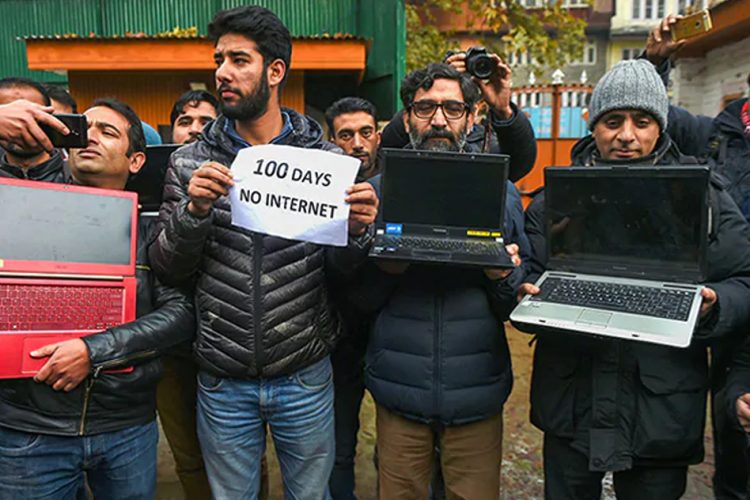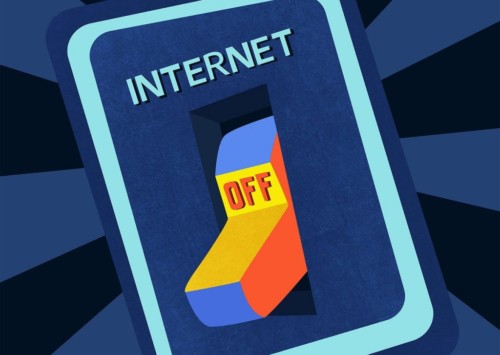Shut the **internet** up!
The world’s largest democracy is shutting down the internet far more than any other country. It is not only snatching away people’s rights to free speech but is costing the economy at the same time.
What are the issues that the government is targeting these days? Unemployment, nah! GDP, nah! Students, yes maybe! (Considering their protests are a big issue for the government). Well, the correct answer is the internet!
Internet shutdowns have become a frequent phenomenon in the country over the past several years. The country severed connectivity 93 times this year alone and 134 times last year, more than any other country, according to a monitoring group. Software Freedom Law Centre (SFLC), a legal advocacy group in New Delhi, tracked India’s shutdowns since 2012 using reports from journalists, advocacy groups and citizens. Also, in 2018, the #KeepItOn coalition—which works with the support of 191 organisations globally—and the non-profit Access Now reported that of the 196 internet shutdowns collated from 25 countries, India was responsible for the majority: with 134 incidents, 67 pc of the world’s documented shutdowns took place in India last year. Facebook’s Transparency Report, released last month, identified close to 70 disruptions of Facebook services in 15 countries in the first half of 2019—India accounted for 40 of these.
What’s even more shocking is that the Department of Telecommunications in India does not maintain data on shutdowns ordered by states. This has been the government’s stock response to questions in Parliament on the number of internet shutdowns. SFLC, which gets most of its data from national and regional newspapers, cautions that “our data is as reliable as the sources it comes from”; however these data are virtually the only ones available on internet shutdowns, and are referred to widely.
Internet shutdowns are the best option for the government to silence the voice of millions of citizens. Services were suspended in Agra and Aligarh in Uttar Pradesh and parts of Rajasthan and Madhya Pradesh right ahead of the Ayodhya verdict by the Supreme Court in November. The union territory of Jammu and Kashmir has had no internet services for more than 135 days, making it the second longest period in India ever. The previous longest internet shutdown in India was also in Jammu and Kashmir. It lasted 202 days – from July 8, 2016 to January 7, 2017 – following the killing of Hizbul Mujahideen militant Burhan Wani. J&K has seen as many as 193 occasions of internet blocks since 2016, followed by Rajasthan, with 42 such instances. The third longest shutdown was seen in West Bengal’s Darjeeling in 2017 for 100 days linked to the agitation for Gorkhaland.
An authoritarian tactic
Modi’s government is increasingly employing the method of silencing voices all at a time that is seen by many as a tactic used by authoritarians, not democracies. The New York Times writes in an article, “As the government of India pushes increasingly provocative policies, it is using a tactic to stifle dissent that is more commonly associated with authoritarian regimes, not democracies: It is shutting down the internet.”
Even countries like Syria and Turkey that have been on war – each shut down the internet just once in 2018. Only authoritarian governments such as China and Myanmar have cut off the internet services for longer, data from Access Now showed.
“Between mid-2015 to mid-2016, over 19 countries suspended internet access. That number increased to more than 30 in 2017. Notable international examples include the Egyptian government cutting internet services in its entire country for over four days, with China doing the same in its Xinjiang province for over 10 months,” writes Google public policy fellow Nakul Nayak in his September 2018 paper The Legal Disconnect: An Analysis Of India’s Internet Shutdown Laws. “However, it is India that has the dubious distinction of witnessing the most number of shutdowns in the world,” he adds.
“Any time there is a sign of disturbance, that is the first tool in the toolbox,” said Mishi Choudhary, founder of SFLC.in. “When maintenance of law and order is your priority, you are not thinking about free speech,” she added.
The government however justifies its action by saying that they are trying to stop the spread of misinformation, which can outpace their efforts to control it. However, experts believe that the shutdowns are part of the tightening grip of the Modi administration as he is chipping away at India’s traditions of democracy and secularism.
Bending rules as per convenience
Earlier shutdowns were imposed largely under Section 144 of the Code of Criminal Procedure (CrPC), which gave the police and district magistrate powers to prevent unlawful gatherings of people and “direct any person to abstain from a certain act”. However, in August 2017, the Union government promulgated the Temporary Suspension of Telecom Services (Public Emergency or Public Safety) Rules, 2017, under the authority granted to it by the Indian Telegraph Act, 1885. These rules, in ordinary circumstances, trace the legal source of the power to issue shutdown orders to the Union home secretary or the secretary in charge of the home department in a state. This order must then be forwarded to a review committee, which is required to decide on its reasonability within five working days. However, the legality of the shutdowns these days is not tested as most shutdowns are ordered by local authorities after a few calls to local service providers.
Costing the economy
According to estimates in a report by the Indian Council for Research on International Economic Relations (ICRIER), over the past five years, some 16,000 hours of internet shutdowns cost the economy a little over USD 3 billion. The Kashmir Chamber of Commerce and Industry (KCCI) stated last month that the valley had already suffered a loss of over INR 100 billion since August 5. There are traders in Kashmir who even catch a flight to the nearest state just to check their emails.
The shutdown order is first sent to telecom service providers (TSPs), who suffer heavy losses with every shutdown. “According to one estimate, TSPs in Uganda lose up to USD 23 million a day due to internet shutdowns. There is no reason to believe that the opportunity costs to a TSP in India will not be similar,” writes Nayak.
In India the TSPs have no option but to comply, otherwise their licence can be cancelled or a penalty of up to INR 500 million per service area imposed for every violation.











